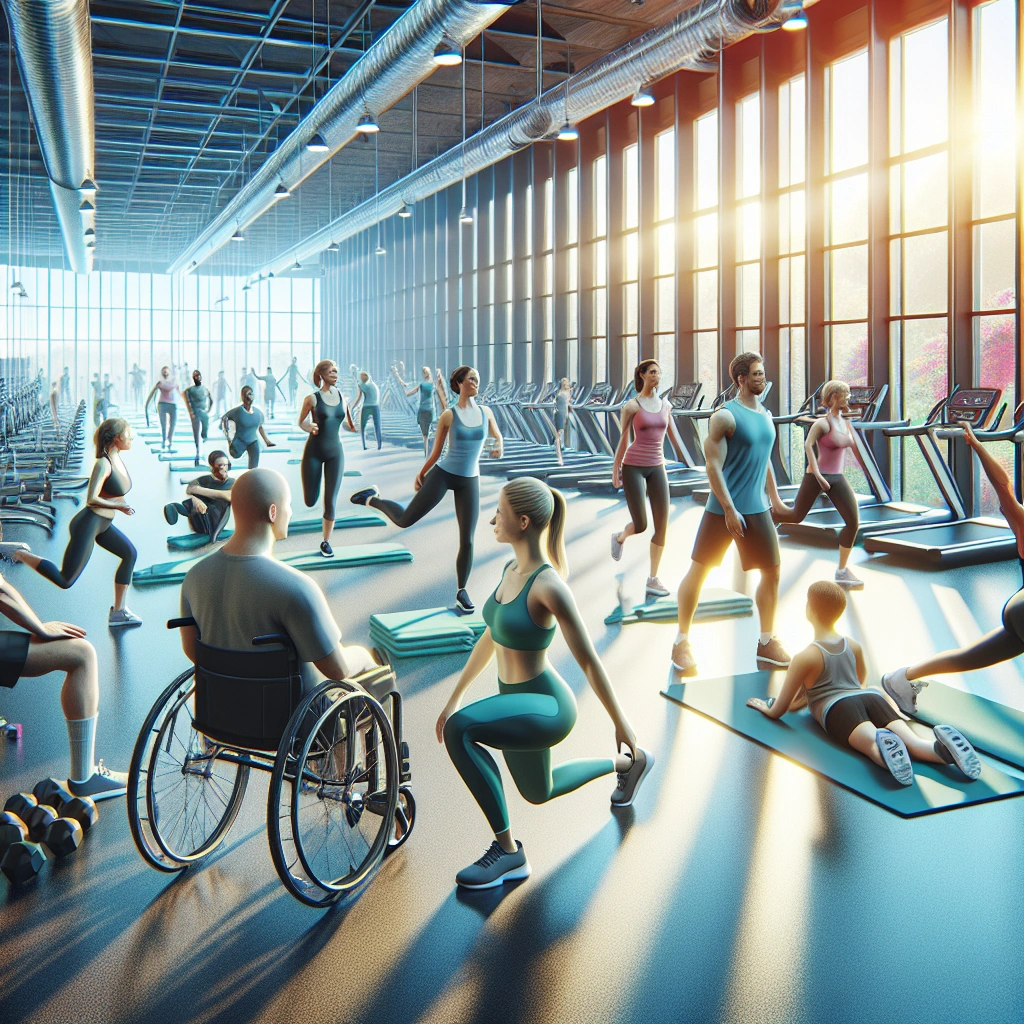

Insulin resistance occurs when cells in the body do not respond well to insulin and cannot easily take up glucose from the blood. This condition can lead to elevated insulin production and weight gain, worsening the insulin resistance.
Exercise plays a crucial role in managing insulin resistance by improving insulin sensitivity and glucose control, minimizing weight gain, and optimizing the lipoprotein profile.
Exercise, especially aerobic and resistance training, is recommended as a key component in the treatment and prevention of type 2 diabetes. Research has shown that both aerobic and resistance exercise training can improve insulin sensitivity and glucose control, leading to better management of insulin resistance.
Furthermore, incorporating flexibility and balance activities, such as yoga and Pilates, may also contribute to improved glycemic control in individuals with insulin resistance.
Studies have also highlighted the importance of different forms of exercise, including walking, standing, and even tai chi, in improving insulin sensitivity and managing insulin resistance. Regular physical activity, including strength training and flexibility exercises, can play a significant role in improving insulin resistance and overall glycemic control.
Check out this Youtube video: “Workout for Insulin Resistance. Follow along … – YouTube” to discover the best exercises to improve insulin resistance and take control of your health.
What is Insulin Resistance?
Insulin resistance refers to a condition where the cells in the muscles, fat, and liver exhibit a reduced response to insulin, leading to a decreased ability to take up glucose from the bloodstream. This results in elevated blood sugar levels, posing various health risks.
Definition of insulin resistance
Insulin resistance is clinically defined as the reduced capacity of exogenous or endogenous insulin to boost glucose uptake and utilization within the body’s cells. Essentially, the cells become less sensitive to the effects of insulin, disrupting the normal glucose absorption process.
Causes of insulin resistance
Various factors contribute to insulin resistance, including genetic predisposition, excessive fat accumulation particularly around the waist, physical inactivity, and certain medical conditions such as hormonal disorders. Additionally, specific medications like steroids and some psychiatric drugs can also induce insulin resistance.
Risk factors for insulin resistance
The risk factors for developing insulin resistance encompass a family history of type 2 diabetes, being overweight or obese, especially with excess fat around the abdomen, and a sedentary lifestyle. Individuals aged 45 and older also face an elevated likelihood of developing insulin resistance.
The Role of Exercise in Improving Insulin Resistance
Regular exercise plays a crucial role in improving insulin sensitivity in the body, particularly in skeletal muscle tissue. Exercise promotes glucose uptake and glycogen restoration post-exercise, thereby aiding in the management of insulin resistance.
How exercise affects insulin sensitivity
Exercise induces an increase in muscle insulin sensitivity, leading to enhanced glucose transport, independent of insulin. This helps in effectively utilizing glucose and managing insulin levels in the body.
The best types of exercise for insulin resistance
The best exercises for improving insulin resistance include aerobic activities like brisk walking, cycling, and swimming. Additionally, resistance training using weights or resistance bands can also significantly improve insulin sensitivity.
| Type of Exercise | Description |
|---|---|
| Aerobic | Brisk walking, cycling, swimming |
| Resistance | Weight training, resistance band exercises |
Aerobic Exercise
Benefits of aerobic exercise for improving insulin resistance
Aerobic exercise offers numerous benefits for improving insulin resistance. It enhances insulin sensitivity and enables better glucose uptake in muscles, thereby aiding in blood sugar management.
Additionally, aerobic exercise helps in reducing overall body fat, which is crucial in combating insulin resistance.
Examples of aerobic exercises
Popular examples of aerobic exercises that are beneficial for improving insulin resistance include brisk walking, jogging, cycling, swimming, and dancing. These exercises elevate heart rate and engage large muscle groups, effectively improving insulin sensitivity and glucose metabolism.
How frequency and intensity impact insulin resistance
The frequency and intensity of aerobic exercises play a significant role in impacting insulin resistance. Engaging in aerobic exercises at least 3-5 times a week, with moderate to vigorous intensity, can substantially enhance insulin sensitivity and improve glucose uptake, leading to better management of insulin resistance.
Resistance Training
The impact of resistance training on insulin sensitivity
Resistance training has been consistently found to improve insulin sensitivity in individuals with type 2 diabetes, as well as in healthy adults. The relationship between strength training and insulin resistance is attributed to the effect on muscle mass and body weight.
Examples of resistance training exercises
| Muscle Group | Exercise |
|---|---|
| Upper body | Push-ups, pull-ups |
| Lower body | Squats, lunges |
| Core | Planks, abdominal crunches |
Engaging in resistance training involves exercises such as push-ups, pull-ups, squats, lunges, planks, and abdominal crunches. These exercises focus on major muscle groups, promoting muscle strength and mass.
Creating a resistance training program for insulin resistance
When designing a resistance training program to improve insulin resistance, focus on multijoint exercises targeting major muscle groups. Include a variety of exercises using free weights, weight machines, resistance bands, cables, and body weight. It is essential to incorporate training that increases muscle mass and strength to enhance insulin sensitivity.
Resistance training offers a valuable approach to improving insulin sensitivity, and incorporating a diverse range of exercises can contribute to a comprehensive resistance training program.
High-Intensity Interval Training (HIIT)
Using HIIT can significantly improve insulin resistance by increasing insulin sensitivity and reducing body mass. This form of exercise also leads to a decrease in body fat percentage and an increase in maximum oxygen intake, which is beneficial for individuals at risk of insulin resistance.
HIIT puts special emphasis on lowering insulin resistance, leading to positive effects on metabolic health.
How HIIT can improve insulin resistance
HIIT improves insulin resistance by enhancing insulin sensitivity and regulating glucose levels. The high-intensity intervals create a metabolic response in the body that promotes better insulin function, thus reducing the risk of insulin resistance.
Sample HIIT workouts for managing insulin resistance
| Exercise | Description |
|---|---|
| Burpees | Combines a pushup and a jump in one movement, engaging multiple muscle groups and challenging endurance. |
| Sprints and Steady | Alternating between sprints and steady pace exercises for improved insulin resistance and overall health. |
HIIT workouts, such as burpees and alternating sprints, contribute to managing insulin resistance, body fat, and overall metabolic health. These exercises have been proven to be effective in combating insulin resistance and improving insulin sensitivity.
This table provides examples of HIIT workouts that are beneficial in managing insulin resistance and improving overall metabolic health for individuals at risk of insulin resistance.
HIIT workouts offer a powerful way to improve insulin resistance and overall metabolic health, making them an effective exercise choice for individuals looking to manage insulin sensitivity and reduce the risk of insulin resistance.
Flexibility and Balance Exercises
The benefits of flexibility and balance exercises for insulin resistance
Flexibility and balance exercises like yoga, Pilates, and tai chi offer numerous benefits for individuals with insulin resistance. These exercises not only enhance joint mobility and reduce the risk of falls but also promote overall well-being and improved physical function.
Examples of flexibility exercises
Flexibility Exercise
Description
Standing Hamstring Stretch
This exercise involves standing tall with feet hip-width apart and bending forward at the hips to stretch the hamstring muscles.
Piriformis Stretch
The piriformis stretch targets the deep internal hip rotator, promoting external rotation and flexibility.
Lunge With Spinal Twist
It is essential for posture-related pain and is beneficial for individuals who sit for prolonged periods.
Incorporating balance training into your exercise routine
Balance can be improved by incorporating simple moves such as alternating lunges, standing marches, step-ups, walking heel-to-toe, and standing on one leg for a few seconds. These simple yet effective exercises can significantly enhance balance and stability, reducing the risk of falls and fractures.
Lifestyle Factors Affecting Insulin Resistance
To manage insulin resistance effectively, it’s crucial to pay attention to your diet. Consuming foods low in refined or simple carbohydrates can significantly help in managing sugar levels and improving insulin resistance.
This includes incorporating healthy fats, nuts, nut butter, cooking oils like avocado oil, and fatty fish into your meals.
The role of diet in managing insulin resistance
A well-balanced diet with a focus on complex carbohydrates, healthy fats, and lean protein can play a key role in managing insulin resistance. Incorporating foods like nuts, seeds, fatty fish, and low-fat dairy products can significantly improve insulin sensitivity.
The importance of sleep and stress management for insulin sensitivity
Inadequate sleep and chronic stress can have a detrimental impact on insulin sensitivity. Getting enough restorative sleep and employing effective stress-management techniques, such as meditation, yoga, deep breathing, or spending time outdoors, are essential for improving insulin sensitivity.
Studies have linked insufficient sleep with reduced insulin sensitivity, emphasizing the critical role of adequate sleep in managing insulin resistance.
Monitoring Progress
To track improvements in insulin resistance, it’s essential to employ various methods such as regular blood tests to monitor fasting insulin levels, glucose tolerance tests, and HbA1c tests to measure long-term blood sugar control. Additionally, tracking changes in body composition, such as waist circumference and body fat percentage, can provide insights into insulin sensitivity improvements.
Methods for tracking improvements in insulin resistance
- Regular blood tests for fasting insulin levels
- Glucose tolerance tests
- HbA1c tests for long-term blood sugar control
- Tracking changes in body composition, such as waist circumference and body fat percentage
When it comes to the relationship between exercise and other health markers, studies have shown that regular physical activity not only improves insulin sensitivity but also positively impacts other health indicators. These include reduced blood pressure, improved cardiovascular health, and better overall glucose metabolism.
Regular exercise can also lead to increased energy levels and improved mood, contributing to an overall sense of well-being.
The relationship between exercise and other health markers
| Health Marker | Improvement due to Exercise |
|---|---|
| Insulin sensitivity | Improved with regular physical activity |
| Blood pressure | Reduction in both systolic and diastolic blood pressure |
| Cardiovascular health | Enhanced through improved heart function and circulation |
| Glucose metabolism | Better regulation, leading to more stable blood sugar levels |
| Energy levels and mood | Increased energy and improved mood as a result of regular exercise |
Tracking improvements in insulin resistance can be achieved through various methods, including blood tests and body composition measurements. Moreover, regular exercise not only improves insulin sensitivity but also positively impacts other health markers, contributing to overall well-being.
Consistency and Compliance
Strategies for maintaining a regular exercise routine
One effective strategy for maintaining a regular exercise routine is to find an exercise that you genuinely enjoy and that aligns with your fitness level. This could be a fitness class, going for a run, or practicing yoga.
By choosing activities that you find enjoyable, you are more likely to stick to your exercise routine and remain consistent.
Another important strategy is to set achievable and realistic fitness goals. Whether it’s increasing your daily step count or aiming to attend a certain number of workout sessions per week, setting achievable goals can help maintain your motivation and commitment to exercise.
Tracking your progress and celebrating your accomplishments along the way is also essential for staying consistent.
Additionally, incorporating variety into your workout routine is crucial. This variety can help prevent boredom, reduce the risk of overuse injuries, and target different muscle groups for overall fitness.
By mixing up your exercise routine with different activities such as cardio, strength training, and flexibility exercises, you can keep your workouts exciting and engaging.
Overcoming barriers to exercise adherence
To overcome barriers to exercise adherence, it’s important to address common obstacles such as lack of time, energy, motivation, or skill. One effective way to do this is by scheduling your workouts like important appointments.
Making exercise a non-negotiable part of your daily or weekly calendar can help prioritize physical activity and overcome the barrier of time constraints.
Finding a workout buddy or joining a fitness community can also provide valuable social support and motivation, helping to combat the barrier of lack of motivation. This can make exercise more enjoyable and hold you accountable, increasing the likelihood of adhering to your workout routine.
Moreover, identifying and addressing specific barriers that personally affect you, such as lack of energy or skill, is crucial. Whether it involves adjusting your workout timing, seeking professional guidance, or modifying the type of exercise you engage in, addressing these barriers directly can significantly enhance adherence to your exercise regimen.
| Barrier | Strategy |
|---|---|
| Lack of time | Schedule workouts as non-negotiable events |
| Lack of energy | Adjust workout timing based on energy levels |
| Lack of motivation | Find a workout buddy or join a fitness group |
| Lack of skill | Seek professional guidance for proper training |
Adapting Exercise for Different Fitness Levels
Modifying exercises for beginners
To adapt exercises for beginners, it’s important to start slowly and focus on form to prevent injury. Simple modifications include performing wall push-ups instead of traditional push-ups, doing knee push-ups, and using resistance bands for assistance with exercises like pull-ups.
These modifications help beginners build strength and endurance gradually.
Challenging workouts for advanced fitness levels
For advanced fitness levels, it is important to incorporate high-intensity interval training (HIIT), plyometric exercises, and advanced strength training techniques. Examples of challenging workouts include box jumps, muscle-ups, and kettlebell swings.
These workouts push the body beyond normal limits, leading to increased muscle strength and overall fitness gains.
| Beginner Modifications | Advanced Workouts |
|---|---|
| Wall Push-Ups | High-Intensity Interval Training (HIIT) |
| Knee Push-Ups | Plyometric Exercises |
| Resistance Band Assisted Exercises | Advanced Strength Training Techniques |
Potential Risks and Considerations
Understanding the potential risks of exercise for individuals with insulin resistance
Exercise for individuals with insulin resistance carries potential health risks, including acute complications such as cardiac events, hypoglycemia, and hyperglycemia. However, low- and moderate-intensity activities for adults with type 2 diabetes pose a low risk of exercise-induced adverse events.
Precautions to take when starting an exercise program
When initiating an exercise program, individuals with insulin resistance should consider taking certain precautions. It’s important to consult with a healthcare provider to determine the most suitable exercise regimen.
Precautions may include monitoring blood glucose levels before, during, and after exercise, as well as making necessary adjustments to medication and dietary intake to prevent hypoglycemia. Additionally, individuals with insulin resistance should start with low-impact activities and gradually increase intensity to minimize the risk of adverse effects.
| Precautions for Starting an Exercise Program |
|---|
| Consult healthcare provider before initiating an exercise regimen |
| Monitor blood glucose levels before, during, and after exercise |
| Gradually increase exercise intensity to minimize risk of adverse effects |
| Make necessary adjustments to medication and dietary intake to prevent hypoglycemia |
Combining Exercise with Other Treatment Approaches
When it comes to the synergistic effects of exercise and medication for insulin resistance, the combination of both treatments has shown to significantly enhance insulin sensitivity and oppose the progression from prediabetes to type 2 diabetes. This approach is more effective as each treatment stimulates AMP-activated protein kinase activity in skeletal muscle, thereby combatting insulin resistance more effectively.
Integrating exercise with other lifestyle modifications is crucial in the management of insulin resistance. Combining exercise with dietary changes, weight management, and other healthy lifestyle habits can significantly improve the body’s response to insulin and contribute to overall health and well-being.
Engaging in Physical Activity Throughout the Day
Incorporating movement into daily routines
Physical activity should be incorporated into daily routines to maintain a healthy lifestyle. Simple activities such as taking the stairs instead of the elevator, parking farther away, or using a standing desk can help increase movement throughout the day.
The benefits of breaking up sedentary behavior with physical activity
Breaking up sedentary behavior with physical activity has numerous health benefits. It can enhance mood, increase physical activity levels, improve mental health, and contribute to overall well-being.
Regular movement breaks are essential for maintaining optimal health and reducing the risks associated with prolonged sitting.
The Psychological Impact of Exercise
How exercise can improve mood and mental well-being
Exercise has a profound impact on mood and mental well-being. It triggers the release of endorphins and serotonin, commonly referred to as “feel good” chemicals, which can uplift your mood and create a sense of well-being.
Additionally, physical activity alleviates stress and tension, boosts both physical and mental energy, and can act as a distraction from negative thought patterns. Through these mechanisms, exercise becomes a powerful tool for enhancing mental health.
Overcoming psychological barriers to exercise adherence
Many individuals face psychological barriers to maintaining a consistent exercise routine. Factors such as distress, depression, lack of motivation, and low self-confidence can hinder adherence.
Addressing these barriers is crucial for sustaining a long-term commitment to exercise. By cultivating a supportive environment, setting realistic goals, and seeking professional guidance, individuals can overcome these psychological obstacles and establish a positive and lasting relationship with exercise.
Community Support and Resources
Finding support and motivation for regular physical activity
If you need support and motivation for regular physical activity, look no further! Engaging in physical activity can be challenging, but with the right support system, you can stay motivated and consistent.
Join community-based fitness groups, connect with friends or family members who share similar fitness goals, or seek the guidance of a fitness Coach. These avenues provide opportunities for encouragement, accountability, and social interaction, making your fitness journey more enjoyable and sustainable.
Accessing resources for exercise guidance and instruction
When it comes to accessing resources for exercise guidance and instruction, there are several avenues to explore. Consider seeking out local fitness centers or gyms that offer professional guidance from certified trainers.
Additionally, online platforms and mobile applications provide a wealth of instructional resources, including exercise videos, workout plans, and virtual fitness communities. Remember, having access to reliable exercise guidance and instruction is crucial for ensuring that you perform exercises correctly and safely.
| Resource | Description |
|---|---|
| Local Fitness Centers | Professional guidance from certified trainers |
| Online Platforms | Exercise videos, workout plans, virtual fitness communities |
Recommended Amazon Products for Best Exercise to Improve Insulin Resistance
Here’s a curated list of products that can help you achieve your goal of improving insulin resistance with ease. These recommendations are based on functionality, price, and positive customer reviews.
1. Fitbit Charge 4 Fitness and Activity Tracker
The Fitbit Charge 4 is a versatile fitness tracker that can help you monitor your exercise intensity and track your progress in managing insulin resistance. It offers built-in GPS, heart rate monitoring, and a variety of exercise modes to suit your workout needs.
With its long battery life and compatibility with the Fitbit app, it’s a great tool for staying motivated and tracking your fitness goals.
Pros and Cons of Fitbit Charge 4 Fitness and Activity Tracker
| Pros | Cons |
|---|---|
| Monitors exercise intensity and heart rate | Can be pricey for some users |
| Long battery life | Some users may find it complex to set up |
| Compatible with Fitbit app for comprehensive fitness tracking | Constant use of GPS can drain battery faster |
2. TheraBand Resistance Bands Set
Resistance training is key to improving insulin sensitivity, and the TheraBand Resistance Bands Set offers a versatile and convenient way to engage in resistance exercises at home. With varying resistance levels and a comprehensive guide, this set allows you to tailor your workouts to your fitness level and needs.
The portability of resistance bands makes it easy to incorporate resistance training into your exercise routine wherever you are.
Pros and Cons of TheraBand Resistance Bands Set
| Pros | Cons |
|---|---|
| Versatile with varying resistance levels | Some users may prefer traditional weights over resistance bands |
| Portable and convenient for home workouts | Bands may wear out over time with heavy use |
| Comes with a comprehensive exercise guide | Limited range of motion compared to free weights |
3. Schwinn 270 Recumbent Bike
A recumbent bike is an excellent choice for low-impact aerobic exercise, which is beneficial for managing insulin resistance. The Schwinn 270 Recumbent Bike offers a comfortable and customizable workout experience with its adjustable seat, pre-programmed workouts, and heart rate monitoring.
Its built-in speakers and USB charging port make it convenient to enjoy entertainment while exercising.
Pros and Cons of Schwinn 270 Recumbent Bike
| Pros | Cons |
|---|---|
| Comfortable and adjustable seating | Takes up more space compared to upright bikes |
| Pre-programmed workouts and heart rate monitoring | Some users may find assembly challenging |
| Built-in speakers and entertainment options | Higher price point compared to basic exercise bikes |
Top Recommended Product for Best Exercise to Improve Insulin Resistance
If you’re looking for the best solution for improving insulin resistance, we highly recommend the Fitbit Charge 4 Fitness and Activity Tracker. Here’s why:
The Fitbit Charge 4 offers a comprehensive set of fitness tracking features, including heart rate monitoring, exercise intensity tracking, and compatibility with the Fitbit app for in-depth progress monitoring. The long battery life and built-in GPS make it a versatile tool for tracking your workouts and staying motivated to improve insulin resistance.
Ready to improve your insulin resistance? Check out the Fitbit Charge 4 Fitness and Activity Tracker today for the best results!


Conclusion
It is clear that weight loss surgery can be an effective option for individuals who have struggled with obesity and failed to see results with other methods. The different types of weight loss surgeries each have their own benefits and considerations, so it is important for patients to thoroughly discuss their options with a medical professional before making a decision.
Despite the potential risks and complications, many patients have found significant success and improvement in their overall health and quality of life after undergoing weight loss surgery.
Weight loss surgery has been shown to not only help individuals achieve significant weight loss, but also to improve or resolve obesity-related health conditions such as diabetes, high blood pressure, and sleep apnea. It is important to note, however, that successful outcomes often require a commitment to long-term lifestyle changes, including a healthy diet and regular physical activity.
Additionally, ongoing medical follow-up and support are essential for ensuring the best possible results and minimizing potential risks associated with weight loss surgery.
While weight loss surgery can offer hope for individuals struggling with obesity, it is not a one-size-fits-all solution. Patients should carefully consider the potential benefits and risks, as well as the necessary commitment to lifestyle changes, before pursuing weight loss surgery as a treatment option.
With the appropriate support and follow-up care, weight loss surgery can be a life-changing decision for those who have struggled with obesity.








